SUBJECTS
GRADE
Show Results
Screamin' Roller Coasters
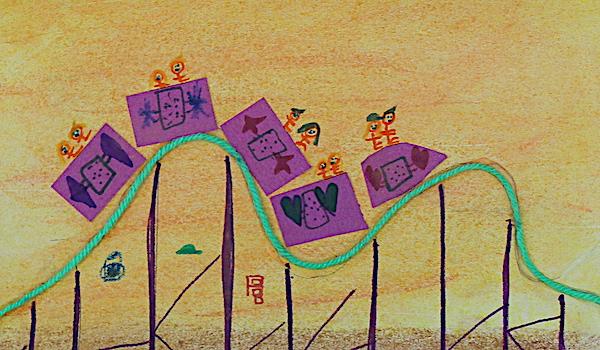
Lesson Summary
- Communicate observations about falling objects.
- Create a roller coaster as a class.
- Learn how to use chalk pastels.
- Discuss Edvard Munch’s art composition The Scream.
Lesson Plan and Procedure
Lesson Key Facts
- Grade(s): 3
- Subject(s): English Language Arts, Science, Visual Arts
- Duration of lesson: 50 minutes
- Author(s): Molly Neves
Introduction
Teacher: Have you ever ridden a roller coaster? What makes a roller coaster so exciting? Let’s read a book about roller coasters. Pay attention to the emotions the illustrations depict. Pay particular attention to the young girl’s emotions, and think about times you may have felt the same way she does.
Read Roller Coaster by Marla Frazee. Guide students in a discussion to help them understand the perspective of the girl in the story.
Teacher: How do you think she is feeling? 
The illustrations are full of details. Point out the details as you read, helping the students understand that the details make the illustrations interesting and tell a story in themselves.
Forces of Motion
Begin by going back through the book and focusing the students’ attention on the items that fall during the ride, e.g., a man’s gray cap, a pair of sunglasses, and a boy’s yellow hat. Discuss the path that objects may take as they fall. Refer back to the illustrations and students’ prior knowledge of objects falling.
Teacher: Let’s talk about what happens to objects that may fall out when you go on a roller coaster. What path could the man’s gray baseball cap in the book have taken? How about the sunglasses? Do all things fall without any interference? What are some things that can prevent these items from falling to the ground? Let’s follow the path of the boy’s yellow hat in the story.
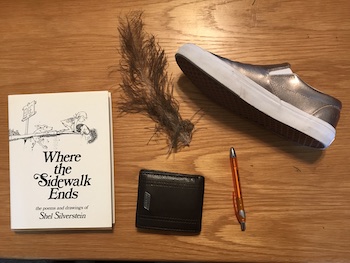
Hold two objects up, such as a wallet and a pen, and ask students to predict which will fall to the floor first. Give students an opportunity to share the reasons for their choices. Drop the two objects at the same time to test their reasoning. Have students share their observations. Now hold up the wallet and a book, ask the students to make another prediction, and then test it. Do this again with the wallet and a shoe. Again, give students the opportunity to share their observations. The items will, in most cases, hit the floor at the same time. Help students understand that objects with a similar mass will fall at the same rate to the floor, unless there’s an interference.
Teacher: What would happen if you dropped a feather and a wallet at the top of the roller coaster? Would both of them hit the ground at the same time? (Take a vote with the class.)
Demonstrate by dropping a wallet and a feather, and see which one hits the ground first. The wallet will hit the floor first because of the interference of the air. If the feather and wallet were dropped in a vacuum chamber, they would fall at the same rate and hit the ground at the same time because of natural laws. Take the time necessary to help students understand the science concepts.
The Scream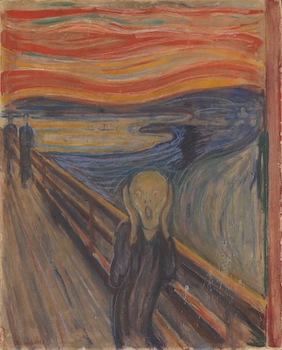
Teacher: How do you feel when you ride a roller coaster? I want to show you a painting of how I feel when I ride a roller coaster.
Show Edvard Munch’s The Scream to the students.
Teacher: How do you think this person feels? What makes you think that? What are some details you notice about this picture? How did the artist communicate how he felt in this painting? Why do you think the artist chose these colors? Sometimes artists use colors to show emotion.
Studio Time
Beforehand, make sure you have a piece of yarn or ribbon for each student, each piece precut to two and a half feet, as well as some pre-marked papers so that your roller coaster is continuous. Mark numbers 1–20 (or up to however many students are in the class) on the back side of the papers. Then make hash marks on the sides of the papers so that the coaster is connected when it is displayed together. Also, cut small rectangles (1 in x 1½ in) of colored paper, approximately three or four for each student.
Show students how to use chalk pastels; they can draw and blend them with a Kleenex, paper towel, or a Q-tip. They should use sky colors and ground colors that are similar. Have them color the top of the paper in sky colors and the bottom in colors used for ground. Have the students refer back to the painting to create an interesting sky. The class can decide which colors they want to use to make it cohesive. The ground should only be the bottom inch or so of the paper. Measuring two or three fingers from the bottom is a good way to help students get the right proportion.
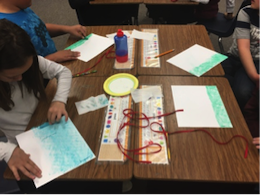


Make sure there are plenty of wipes at each table for the students to use. Encourage the students to shake their artwork over the garbage can to control the dust. Be careful not to blow the chalk dust in this activity!
If time permits, stop the studio time at this point. Spraying the art with an inexpensive aerosol hairspray will help to fix the chalk to the paper and keep it from smudging.
After the background is colored, have students draw with a pencil the track their coaster will take. Make sure the track begins at the hash mark on the right side of the paper and ends at the hash mark on the left side of the paper. Students will then draw a line of Elmer’s glue over their pencil mark and glue down their ribbon or string for the coaster track.
After the track is secured, students can use rulers and colored pencils to draw the vertical supports for the rollercoasters. You can show various images of roller coasters if students need a visual aid to see how roller coasters are supported.



Pass out the squares of colored paper and let the students glue their coaster cars to the track. Instruct them to add details such as people, flags, signs, and so on. They can refer to Marla Frazee’s illustrations for ideas. To reinforce the science standards, have the students put a wallet, a book, or another object falling in their artwork.
When the projects are completed, line up the artwork in numerical order, aligning the hash marks. Hang the projects as one continuous roller coaster.
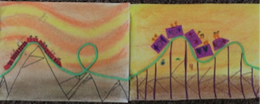
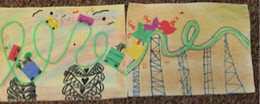
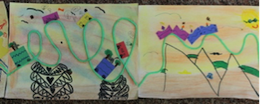
Learning Objectives
- Describe the path falling objects take, and compare different objects as they fall.
- Understand a character’s point of view in a story.
- Respond to works of art and describe subject matter and artistic choices.
- Create a work of personal interest with varied supplies.
Utah State Board of Education Standards
This lesson can be used to meet standards in many grades and subject areas. We will highlight one grade’s standards to give an example of application.
Grade 3 Science with Engineering Education (SEEd)
Standard 3.3.3: Construct an explanation that the gravitational force exerted by Earth causes objects to be directed downward, toward the center of the spherical Earth. Emphasize that "downward" is a local description depending on one’s position on Earth. (PS2.B)
Grade 3 English Language Arts
Standard 3.R.5: Ask and answer questions to demonstrate understanding of a text, referring explicitly to the text as the basis for the answers. (RL & RI)
Standard 3.R.7: Describe characters in a story and explain how their actions contribute to the sequence of events. (RL)
Standard 3.R.12: Explain how specific illustrations or text features contribute to what is conveyed by the words in a text. (RL & RI)
Grade 3 Visual Arts
CREATE (3.V.CR.): Students will generate artistic work by conceptualizing, organizing, and completing their artistic ideas. They will refine original work through persistence, reflection and evaluation.
Standard 3.V.CR.2: Create a personally satisfying artwork using a variety of artistic processes and materials.
Standard 3.V.R.2: Analyze use of media to create subject matter, characteristics of form and mood.
Equipment and Materials Needed
- Frazee, Marla. Roller Coaster. New York: Scholastic, 2005.
- Image of The Scream by Edvard Munch
- Wallet
- Book
- Shoe
- Feather
- White drawing paper
- Rulers
- Colored pencils
- Brightly colored string, yarn, or ribbon cut into 2 ½–foot lengths (one for each student)
- Construction paper cut into rectangles of 1 in X 1½ in (3–4 per student)
- Elmer’s glue
- Chalk pastels
- Wipes
- Tissues
- Pencils
- Images of roller coasters
Additional Resources
- If your library does not have the book Roller Coaster, it can be found here: https://www.amazon.com/Roller-Coaster-Marla-Frazee/dp/0152057447/ref=sr_1_6?ie=UTF8&qid=1521863501&sr=8-6&keywords=marla+frazee
- This link leads to a description of The Scream: https://en.wikipedia.org/wiki/The_Scream
- If the book is not available, here is a video of the book being read aloud: https://www.youtube.com/watch?v=bkduRpnXwq0
Image References
- Image 1–3: Brenda Beyal.
- Image 4: https://commons.wikimedia.org/wiki/File:Edvard_Munch_-_The_Scream_-_Google_Art_Project.jpg
- Image 5–13: Brenda Beyal.

www.education.byu.edu/arts/lessons
 Download
Download